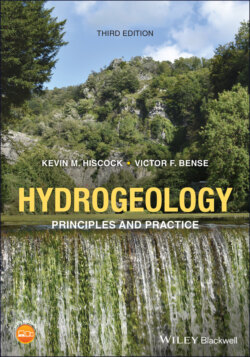Читать книгу Hydrogeology - Kevin M. Hiscock - Страница 18
1 Introduction 1.1 Scope of this book
ОглавлениеThis book is about the study of hydrogeology and the significance of groundwater in the terrestrial aquatic environment. Water is a precious natural resource, without which there would be no life on Earth. We, ourselves, are comprised of two‐thirds water by body weight. Our everyday lives depend on the availability of inexpensive, clean water and safe ways to dispose of it after use. Water supplies are also essential in supporting food production and industrial activity. As a source of water, groundwater obtained from beneath the Earth's surface is often cheaper, more convenient and less vulnerable to pollution than surface water.
Groundwater, because it is unnoticed underground, is often unacknowledged and undervalued resulting in adverse environmental, economic and social consequences. The over‐exploitation of groundwater by uncontrolled pumping can cause detrimental effects on neighbouring boreholes and wells, land subsidence, saline water intrusion and the drying out of surface waters and wetlands. Without proper consideration for groundwater resources, groundwater pollution from uncontrolled uses of chemicals and the careless disposal of wastes on land cause serious impacts requiring difficult and expensive remediation over long periods of time. Major sources of contamination include agrochemicals, industrial and municipal wastes, tailings and process wastewater from mines, oil field brine pits, leaking underground storage tanks and pipelines, and sewage sludge and septic systems.
Achieving sustainable development of groundwater resources by the future avoidance of over‐exploitation and contamination is an underlying theme of this book. By studying topics such as the properties of porous material, groundwater flow theory and geological processes, well hydraulics, groundwater chemistry, environmental isotopes, contaminant hydrogeology and techniques of groundwater remediation and aquifer management, it is our responsibility to manage groundwater resources to balance environmental, economic and social requirements and achieve sustainable groundwater development (Fig. 1.1).
The 10 chapters of this book aim to provide an introduction to the principles and practice of hydrogeology and to explain the role of groundwater in the aquatic environment. Chapter 1 provides a definition of hydrogeology and charts the history of the development of hydrogeology as a science. The water cycle is described and the importance of groundwater as a natural resource is explained. The legislative framework for the protection of groundwater resources is introduced with reference to developed and developing countries. Chapters 2–4 discuss the principles of physical and chemical hydrogeology that are fundamental to an understanding of the occurrence, movement and chemistry of groundwater in the Earth's crust. The relationships between geology and aquifer conditions are demonstrated both in terms of flow through porous material and rock‐water interactions. Chapter 5 provides an introduction to the application of environmental isotopes in hydrogeological investigations for assessing the age of groundwater recharge and includes a section on noble gases to illustrate the identification of palaeowaters and aquifer evolution.
Fig. 1.1 The achievement of sustainable groundwater development through the balance of recharge inputs to aquifer storage (the groundwater resource) against discharge outputs for economic, environmental and human (social) benefits (Hiscock et al. 2002).
(Source: Hiscock, K.M., Rivett, M.O. and Davison, R.M. (2002) Sustainable groundwater development. In: Sustainable Groundwater Development (eds K.M.Hiscock, M.O.Rivett and R.M.Davison). Geological Society, London, Special Publications 193, pp. 1–14. © 2002, Geological Society of London.)
In the second half of this book, Chapters 6 and 7 provide an introduction to the range of field investigation techniques used in the assessment of catchment water resources and includes stream gauging methods, well hydraulics and tracer techniques. The protection of groundwater from surface contamination requires knowledge of solute transport processes, and Chapter 8 introduces the principles of contaminant hydrogeology. Chapter 8 also covers water quality criteria and discusses the nature of contamination arising from a variety of urban, industrial and agricultural sources and also the causes and effects of saline intrusion in coastal regions and oceanic islands. The following Chapter 9 discusses methods of groundwater pollution remediation and protection, and includes sections that introduce risk assessment methods and spatial planning techniques. The final chapter, Chapter 10, returns to the topic of catchment water resources and demonstrates integrated methods for the management of groundwater together with consideration of groundwater interactions with rivers and wetlands, as well as the potential impacts of climate change on groundwater. Given the drive to net‐zero carbon emissions by 2050, the role and interaction of groundwater in the exploitation of energy resources, including renewable resources and shale gas, is reviewed. Finally, Chapter 10 concludes with a description of approaches to groundwater governance and management for the long‐term sustainability of groundwater resources.
Each chapter in this book concludes with recommended further reading to help extend the reader's knowledge of hydrogeology. In addition, for students of hydrogeology, a set of discursive and numerical exercises are provided in Appendix 10 to provide practice in solving groundwater problems. The remaining appendices include data and information in support of the main chapters of this book and will be of wider application in Earth and environmental sciences.
